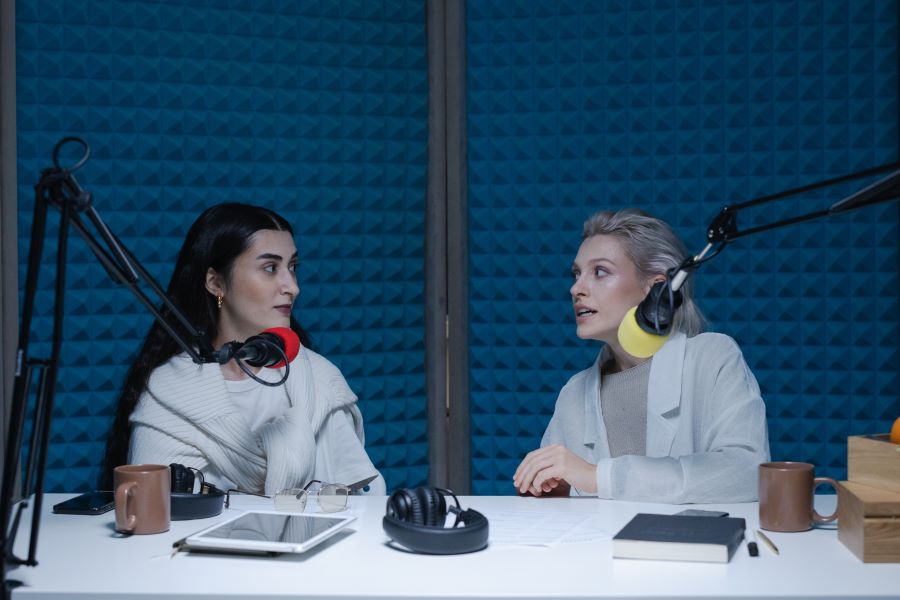Microphones are essential for a podcast. How will you communicate with your listeners if there isn’t something available to hear and record what you say?
As more podcasters explore visual elements and livestreaming with their episode creation, another essential item to consider is the background video.
What is a video drop? It is a way to change the visual environment of your podcast. You have three basic options.
- You can show everyone what is in the room, which you see with livestreams from Joe Rogan and other popular podcasters.
- A virtual backdrop can place a static picture behind you on the screen that hides the background.
- A physical backdrop allows you to record in front of a screen with the option to place animated graphics or other elements in the background during your post-production work.
Related: 17 Best Podcast Recording Software for Mac and PC [2023] and What is Joe Rogan’s Podcast Studio Setup?
Why Choose a Podcast Background Video?
When people show off their own realities, it can make them feel vulnerable when communicating or creating content. Although it’s a way to let others know who you are, it can also be the trigger to start conversations you don’t want to have.
If you have interesting items on your bookshelf, people will potentially judge the items they see. Instead of discussing something from your podcast, you could find yourself stuck defending why you prefer one author over another.
That’s not to say that a podcast background video is infallible. Virtual backgrounds create a higher risk of a mishap. It could degrade your streaming quality, change bandwidth accessibility, or cause you to disappear from the screen.
The goal should be to enhance your podcast or livestream. Whether you choose a physical video that plays in the background or a digital backdrop you superimpose on the screen, the results should invite people to the conversation.
Related: What is the Difference Between a Podcast and a Vodcast?
How to Pick Background Video for a Podcast
The best time to use a video background is when you’re on a platform that supports it organically. For many podcasters, that happens when they conduct interviews or provide content on Zoom.
When you have a background video available, you can promote your podcast while on the screen. It keeps your office out of the picture while creating some natural brand recognition opportunities.
You also have the option to use virtual cameras with some programs. Although you’ll get some motion and blur with them, it’s a low-cost way to hide the stuff you don’t want people to see.
If you want to include motion graphics with your podcast, a photo video studio background with a green screen is your best choice. The streaming platform must allow it if you intend to superimpose something on top of it. Otherwise, it’ll just look like a green background to everyone.
Once the structure is selected, you’ll want to pick something that reflects your podcast.
If you’re talking about a specific landmark, such as the Statue of Liberty, you could use a background video of it to enhance your content. As long as you take into account the speed at which it loads and plays, you’ll have ways to protect your privacy while still standing out.
Related: PODCAST PROMOTION: The Complete List (2023).
An Easy Way to Experiment with Background Video
Graphic design template suppliers, such as Snappa, Canva, and BeFunky, provide templates you can easily customize to create your podcast background video. If you blur the colors just a little during the edit, it can appear realistic for your viewers and listeners.
You can find free video backgrounds on many royalty-free image websites, including MixKit. These videos loop in the back while you present content, ensuring that the atmosphere creates an authentic vibe for the content offered.
If you choose a background video to loop, it helps to download one that doesn’t have audio attached with it. Short clips that deliver a seamless look will prevent most bandwidth disruption issues. Try using one with a low frame rate (25 FPS) while sticking with a 720p resolution.
If you decide that a real background is the one to use for your meetings, you’ll want to have it framed correctly and free of clutter. You could add some house plants, collectibles, and a few books you enjoy. The goal should be to create a natural connection with the viewer instead of having it look like things are growing from the top of your head.
A podcast background video enhances the experience for everyone involved when you get it right. Keep it simple, limit motion, and choose or make something that makes sense for the subject you’re discussing to have the best results.
Related: What is the Difference Between Webcasting and Podcasting? and How to Join a Zoom Test Call
